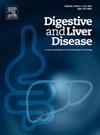Hepatitis B immunoglobulins withdrawal in Hepatitis B Virus mono-infected liver transplant recipients: an Italian multicenter prospective study
IF 3.8
3区 医学
Q1 GASTROENTEROLOGY & HEPATOLOGY
引用次数: 0
Abstract
Background & Aims
Despite recommendations from scientific societies that Hepatitis B Immunoglobulin (HBIG) can be safely discontinued, centers across Europe continue to use the combination nucleoside analogues (NAs) plus HBIG for long-term prophylaxis against Hepatitis B virus (HBV) recurrence after liver transplant (LT). Aim of this study was to evaluate the safety of HBIG withdrawal in a cohort of LT recipients on long-term HBIG+NAs.
Methods
All patients under third-generation NAs+HBIG and who adhered to the INSIGHT-B protocol were followed-up after HBIG withdrawal, in a multicentre, prospective, Italian cohort study, to evaluate the risk of HBV reactivation. Patients transplanted between January 1st, 1991 and December 31st, 2022 were considered for HBIG withdrawal on occasion of the scheduled follow-up visit in the clinic at each site. (Milano-Niguarda, Milano-Policlinico, Bergamo-ASST Papa San Giovanni XXXIII; Pisa-Cisanello; Roma-Umberto I; Torino-Molinette; and Palermo-ISMETT). Informed consent was obtained from all patients before HBIG discontinuation. The probability of HBsAg reappearance after HBIG withdrawal, stratified by presence of HCC at LT, was estimated through Kaplan-Meier curves, and Log-rank tests.
Results
Between February 2021 and January 2024, 222 liver transplant (LT) recipients withdrew HBIG 11.6 (IQR 6.7-17.0) years after LT, and were followed up for a median time of 24 months(fig 1) At LT, 43 (19%) patients were HBV DNA positive. 22% of donors were anti-HBc positive. HBIG were stopped after a median time from LT of 11.6 years (range 1-31 years). After HBIG withdrawal, Hepatitis B surface antigen (HBsAg) reappearance was observed in 12 patients (5.4%) with a cumulative 1-, 2-, and 3-year recurrence rate of 4.08%, 5.36% and 6.89%, respectively (fig. 2). The median time of HBsAg reappearance from HBIG discontinuation was 9 (IQR 4.5–15) months and HBsAg serum levels remained very low over the entire period of observation (median 9 months, range 3-20), and in 4 cases fluctuated around the detectability threshold (tab 1). 10 out of 12 patients experiencing HBsAg reappearance, were continued on hgbNA alone, while 2 were restarted on HBIG (in 1 case for patient preference, in the other on clinician advise). Both patients were restarted on the same HBIG dose they were taking before withdrawal, and both became HBsAg negativeIn all cases HBV-DNA persisted undetectable, liver function tests (LFTs) remained within the normal range and neither HBV-related hepatitis or HCC were observed. 77 patients (27 %) were on LAM at the time of HBIG withdrawal and were switched either to ETV (49%) or to TDF/TAF (51%). 24/77 patients with eGFR < 60ml/min/1.73m2 at the time of HBIG discontinuation were switched to TAF. No significant worsening in renal function was observed during the follow-upNo baseline patients’ features were found to be significantly associated with the likelihood of HBsAg reappearance after HBIG withdrawal, including the presence of HCC at transplantation (tab.2).
Conclusions
In patients receiving high genetic barrier-NA monoprophylaxis, reappearance of HBsAg is not associated with hepatitis when serum HBV-DNA is not detectable. HBIG could be safely withdrawn in HBV mono-infected LT recipients on long-term combination HBIG plus third-generation NAs.
乙型肝炎病毒单感染肝移植受者的乙型肝炎免疫球蛋白戒断:一项意大利多中心前瞻性研究
背景和目的尽管科学协会建议乙型肝炎免疫球蛋白(HBIG)可以安全停用,但欧洲各地的中心继续使用核苷类似物(NAs)联合HBIG长期预防肝移植(LT)后乙型肝炎病毒(HBV)复发。本研究的目的是评估长期HBIG+NAs的LT受体队列中HBIG停药的安全性。方法在一项多中心前瞻性意大利队列研究中,所有接受第三代NAs+HBIG治疗并坚持INSIGHT-B方案的患者在HBIG停药后进行随访,以评估HBV再激活的风险。1991年1月1日至2022年12月31日期间移植的患者在每个地点的诊所进行预定的随访时考虑退出HBIG。(米兰-尼瓜尔达、米兰-波利利尼科、贝加莫-助理圣乔瓦尼老爹三十三、比萨-西萨内洛、罗马-翁贝托一世、都灵-莫利内特和巴勒莫- ismett)。在HBIG停药前获得所有患者的知情同意。通过Kaplan-Meier曲线和Log-rank检验估计HBIG停药后HBsAg再出现的概率,并根据肝细胞癌的存在进行分层。结果在2021年2月至2024年1月期间,222名肝移植(LT)受者在LT后11.6年(IQR 6.7-17.0)撤回HBIG,中位随访时间为24个月(图1)。在LT时,43名(19%)患者HBV DNA阳性。22%的献血者抗hbc阳性。HBIG停药的中位时间为LT后11.6年(范围1-31年)。HBIG停药后,12例患者(5.4%)观察到乙肝表面抗原(HBsAg)复发,累积1年、2年和3年复发率分别为4.08%、5.36%和6.89%(图2)。停药后HBsAg重新出现的中位时间为9个月(IQR为4.5-15),在整个观察期间(中位9个月,范围3-20),血清HBsAg水平保持在非常低的水平,有4例在可检测阈值附近波动(表1)。在12例HBsAg重新出现的患者中,有10例继续单独使用hgbNA, 2例重新开始使用HBIG(1例根据患者偏好,另1例根据临床医生建议)。两名患者重新开始服用停药前相同的HBIG剂量,两名患者均变为HBsAg阴性。所有病例HBV-DNA持续检测不到,肝功能测试(LFTs)保持在正常范围内,未观察到hbv相关肝炎或HCC。77名患者(27%)在HBIG停药时使用LAM,然后切换到ETV(49%)或TDF/TAF(51%)。24/77例停药时eGFR为60ml/min/1.73m2的患者改用TAF。随访期间未观察到肾功能明显恶化,未发现基线患者的特征与HBIG停药后HBsAg复发的可能性有显著相关,包括移植时存在HCC(表2)。结论在接受高遗传屏障na单预防的患者中,当血清HBV-DNA未检测到时,HBsAg的再次出现与肝炎无关。单HBV感染的肝移植受体长期联合HBIG +第三代NAs治疗可安全停药。
本文章由计算机程序翻译,如有差异,请以英文原文为准。
求助全文
约1分钟内获得全文
求助全文
来源期刊

Digestive and Liver Disease
医学-胃肠肝病学
CiteScore
6.10
自引率
2.20%
发文量
632
审稿时长
19 days
期刊介绍:
Digestive and Liver Disease is an international journal of Gastroenterology and Hepatology. It is the official journal of Italian Association for the Study of the Liver (AISF); Italian Association for the Study of the Pancreas (AISP); Italian Association for Digestive Endoscopy (SIED); Italian Association for Hospital Gastroenterologists and Digestive Endoscopists (AIGO); Italian Society of Gastroenterology (SIGE); Italian Society of Pediatric Gastroenterology and Hepatology (SIGENP) and Italian Group for the Study of Inflammatory Bowel Disease (IG-IBD).
Digestive and Liver Disease publishes papers on basic and clinical research in the field of gastroenterology and hepatology.
Contributions consist of:
Original Papers
Correspondence to the Editor
Editorials, Reviews and Special Articles
Progress Reports
Image of the Month
Congress Proceedings
Symposia and Mini-symposia.
 求助内容:
求助内容: 应助结果提醒方式:
应助结果提醒方式:


